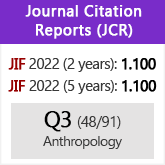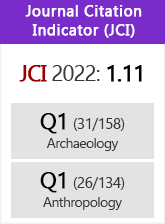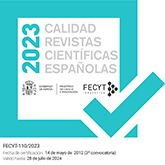The Palaeolithic colonization of Europe: an archaeological and biogeographic perspective
DOI:
https://doi.org/10.3989/tp.1992.v49.i0.508Keywords:
Lower Palaeolithic colonization of Europe, “Pebble-Culture”, Acheulian, “Early European Palaeolithic Horizon”, Handaxes/c1eavers, Homo erectus, Biogeography, Mammalian dispersal events, African carnivores, Dispersal corridor, Filter route, End-Villafranchian/ Galerian dispersal event, Palaeogeography, Levant corridor, Maghreb, Ibero-Moroccan landbridge, Central Asia, Geochronology, Lower-middle Pleistocene, Jaramillo event, Late Matuyama epoch, Brunhes epochAbstract
Current knowledge on the Lower Palaeolithic peopling of Europe is synthesized, using toolmaking repertoires, geochronological. biogeographical and palaegeographic evidence. The oldest traces belong to a non-Acheulian horizon, dating between 0.90 to 0.55 my. Tracing hominid geographic origin and dispersal routes into Europe identifies three alternatives: through the Levant corridor, across Gibraltar strait or more remotely, from a Central Asia filter route. No conclusive proof exists for any of these but there is more coherent empirical support for Central Asia where a non-Acheulian industry is also present. In this alternative, ancient hominid colonization of Europe was synchronous with a major Pleistocene mamalian turnover, the end-Villafranchian/Galerian dispersal event, originating in Central Asia.
Downloads
Download data is not yet available.
Downloads
Published
1992-12-30
How to Cite
Rolland, N. (1992). The Palaeolithic colonization of Europe: an archaeological and biogeographic perspective. Trabajos De Prehistoria, 49, 69–111. https://doi.org/10.3989/tp.1992.v49.i0.508
Issue
Section
Articles
License
Copyright (c) 1992 Consejo Superior de Investigaciones Científicas (CSIC)

This work is licensed under a Creative Commons Attribution 4.0 International License.
© CSIC. Manuscripts published in both the printed and online versions of this Journal are the property of Consejo Superior de Investigaciones Científicas, and quoting this source is a requirement for any partial or full reproduction.All contents of this electronic edition, except where otherwise noted, are distributed under a “Creative Commons Attribution 4.0 International” (CC BY 4.0) License. You may read here the basic information and the legal text of the license. The indication of the CC BY 4.0 License must be expressly stated in this way when necessary.
Self-archiving in repositories, personal webpages or similar, of any version other than the published by the Editor, is not allowed.
















